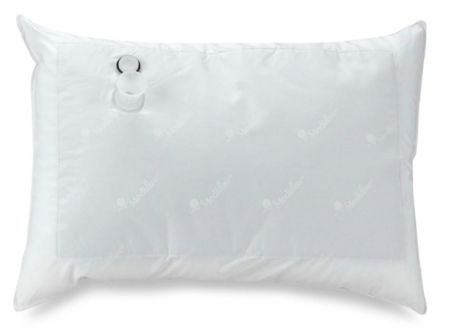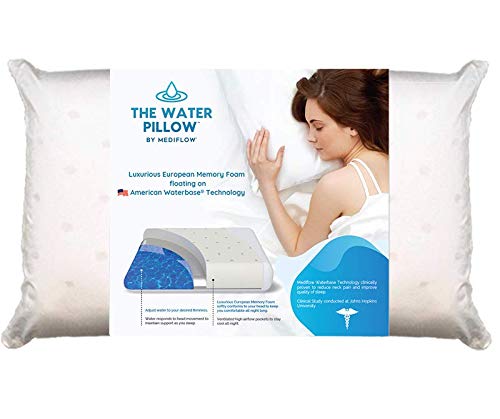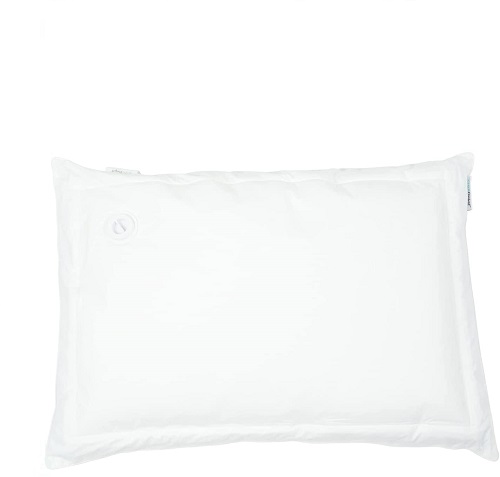Potential benefits associated with water pillows include:
- Pain relief: A 1997 study by the Johns Hopkins University School of Medicine found that water pillows reduced morning pain intensity and enhanced pain relief. The responsive support afforded by the water pouch helps reduce neck and body pain at night and throughout the following day. The pouch conforms to the head and neck as the sleeper shifts positions, ensuring the head, neck and spine are supported throughout the night.
- Improved quality of sleep: The results of the John Hopkins University study also suggested the pillow may be effective in improving quality of sleep over all by reducing nighttime aches. Compared to many models of traditional pillows, the water pillow is better able to maintain its shape and doesn’t require sleepers to routinely wake to readjust or fluff up their pillow.
- Adjustability: Water pillows can be adjusted for height and firmness by adding or removing water from the interior pouch.
- Temperature regulation: The inner water pouch is insulated to prevent heat transfer and keep sleepers cool at night.
- Anti-aging: While most pillows exert pressure against the skin when you lie on your side or stomach, the water pillow conforms to the face. This can help reduce wrinkles and prevent skin irritation.
Potential drawbacks associated with water pillows include:
- Weight: The water pillow may be heavier and more difficult to move than other pillows when the inner pouch is filled.
- Complicated adjustments: Determining the appropriate loft and firmness may require some initial trial and error. While experimenting with different heights and firmness levels, sleepers may have to repeatedly add and/or remove water until they determine their ideal fullness, which can be messy and time consuming.
- Leaking: In rare cases, sleepers have reported leaking from the pillow’s water chamber.
What Type of Sleeper Is Best Suited to a Water Pillow?
Because of their conforming capabilities and adjustable height and firmness, water pillows are a good choice for many different types of sleepers.
Water pillows may be particularly suited for the following users:
- Sleepers who experience head or neck pain. The pillow has been clinically shown to reduce pain — particularly neck pain — during the night and next day.
- Sleepers who prefer multiple options for loft and firmness, or who are unsure of their ideal height or firmness level.
- Sleepers who tend to overheat in the night. The insulating cover of the water pouch is designed to prevent heat transfer, while upper layers of fiber, down, and down alternative may promote airflow.
- Back sleepers, who may require a conforming pillow to reduce pressure points in the neck and other sensitive areas. Water pillows can be adjusted to have a higher loft, which can help support the head and neck better when sleeping face up.
- Side sleepers, who may require a conforming pillow to reduce pressure points on the neck or shoulders. Side sleepers also tend to do well with higher loft pillows, which are more adept at filling the space between the neck and the pillow
Alternatively, water pillows may be less suitable for the following types of sleepers:
- Sleepers looking for a simple, hassle-free pillow, as water pillows may demand time and energy to fill and adjust.
- Some stomach sleepers, who may find the pillow’s loft too high even if the water chamber is empty.
- Sleepers bothered by a noisy pillow, because water pillows with polyester fiber or down alternative pillows may produce noises when compressed.
In addition, different water pillow fillings may be better suited for certain sleepers than others. Here are some rules of thumb to keep in mind when selecting a water pillow filling:
- Memory foam water pillows are best for side sleepers who don’t sleep too hot, as this material can offer exceptional pressure relief for the head and neck but may retain heat.
- Down water pillows are best for back or side sleepers who sleep hot and weigh less than 200 pounds. Down filling is highly breathable, but may not provide sufficient support to sleepers who weigh more than 200 pounds.
- Down-alternative water pillows are best for back and side sleepers who have down allergies, since these pillows mimic the support and feel of down without the associated allergy risk.
- PolyFiber water pillows are appropriate for side, back and stomach sleepers, but may not provide as much pain relief as the other materials.
Which Sizes are Available for Water Pillows?
Water pillows are available in a variety of sizes, though exact specifications may vary by brand. The basic size ranges for water pillows include:
- Travel: 13” x 16” – 13.5” x 21”
- Standard: 16” x 25” – 18” x 26” (Fits regular pillowcases)
- Large/Queen: 20” x 28” (Fits regular or queen pillowcases)
Other Considerations for Water Pillow Shoppers
Beyond design, there are several other factors to take into account when purchasing a water pillow. Before making a buying decision, consider the following:
Cleaning: Review the manufacturer’s cleaning instructions to determine whether your potential pillow has a removable cover that is machine washable, or if it is spot clean only. Note whether the pillow itself can be washed or if it requires special cleaning.
Mattress Encasement: Although water pillows from reputable brands have an excellent track record for avoiding leaks, you may want to use a waterproof mattress encasement to provide an additional layer of protection for your bed against fluids.
Shipping & Delivery: Note the shipping costs and delivery policies for the water pillow. Does the manufacturer offer free shipping to your location? In addition, if you are ordering through Amazon, look to see if the pillow is eligible for free, two-day delivery under Amazon Prime.
Warranty & Returns: If the manufacturer offers a refund policy, note the return window. Familiarize yourself with the warranty of your water pillow. Warranty length can show how much confidence the company puts behind the product. In addition, knowing the water pillow’s warranty may be useful in the event you find a defect after the return window has expired.
Additional Resources


